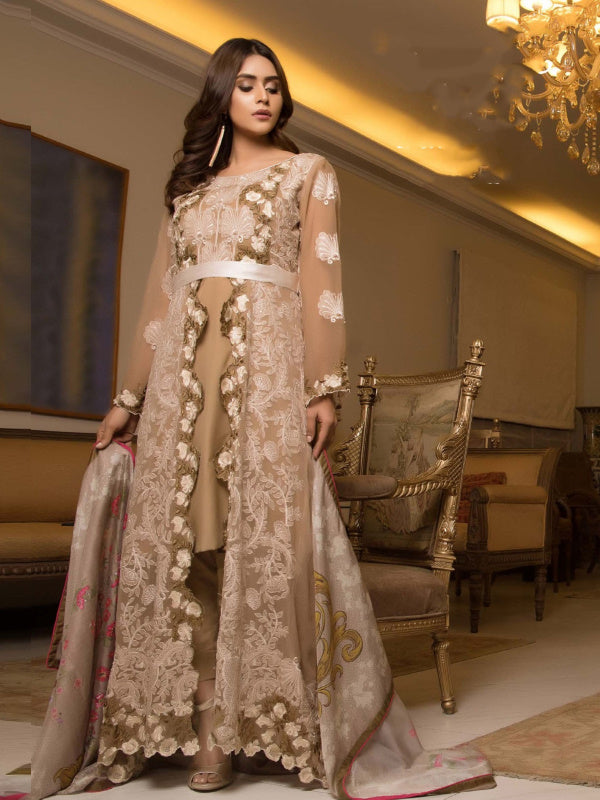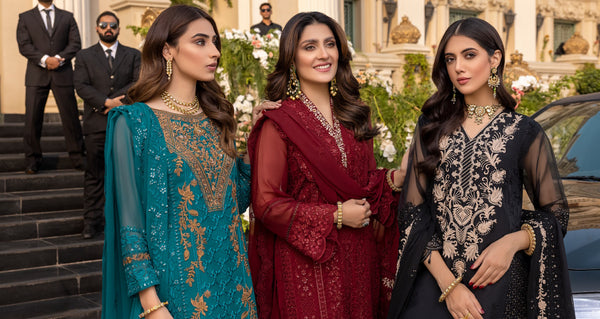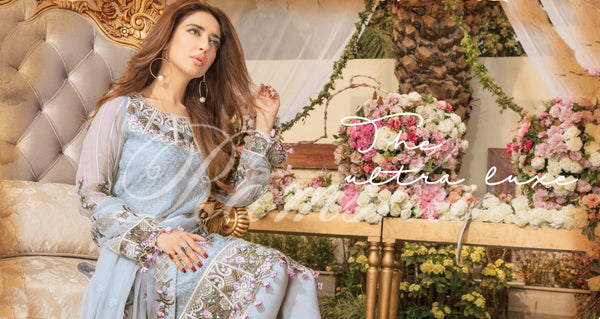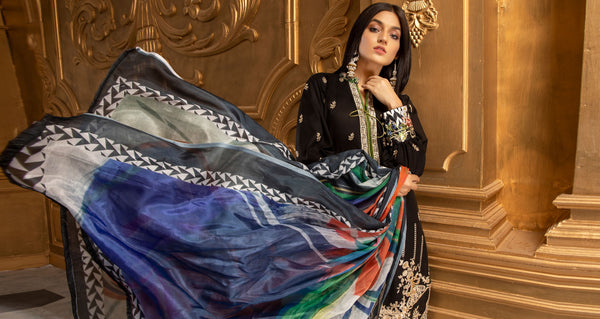History of Pakistan Clothing - Traveling Through Time
Culture and fashion are vital parts of any country’s history and civilization. In Pakistan, both of these are inextricably woven. To understand Pakistan’s fashion, we’ve compiled this brief guide to help take you back in time.
The history of Pakistan dresses is a very colorful and interesting one.
This history not only makes for a great learning experience but also gives insight into everything you need to know to understand why Pakistani fashion is where it is today. As you’ll see, this history of fashion in Pakistan reflects the culture, ideologies, and evolution of the Pakistan people, over time.

Designer Pakistani Suit in Green
Origin of Pakistani Dresses
Based on historical discoveries, Pakistani dresses date back over 7,000 years ago to the Bronze Age. This was during the Indus Valley Civilization era when cotton was first cultivated around 3,000 BC in the Indus River Valley which is now present-day Pakistan.
Pakistan’s geostrategic location also played a big role in its fashion and culture.
The country is bordered by India on the east, Iran by the west, Afghanistan in the northwest, China by the northeast, and the Arabian sea towards the south. This has made Pak nation a great connection point for trade and civilization through history. But then, this has also made it a favorite invasion route for foreign countries through centuries, as well.

Floor length Pakistani Dress
Some of the past invasions, occupation, and settlement in Pakistan have involved diverse foreign cultures from Persians to Arabs, Turks, Mongols, Aryans, Dravidians, Greeks, White Huns, and certain Eurasian groups, among others.
For the country, this has meant the marriage of many cultures with the fashion mainly a blend of both Afghan and Persian elements. Along with this, fashion choices in Pakistan have also been shaped by religious considerations. This marriage of cultures, as well as the religious undertones, explains why Pakistani dresses seem exotic.
Mughal Era Influence on Pakistani Fashion
The Doab continued to suffer continuous Mongol occupation towards the end of the 13th century. The region (present-day Pakistan) was sacked as early as 1303. Fast forward to the 16th century, the Mughals have seized control and ruled most of India and Pakistan.
The Mughals (who are Muslims of Turkic-Mongol origin) consolidated Islam in South Asia. But along with spreading their faith, the Mughals also spread their Persian arts and culture. This cultural influence can easily be seen today with the majority of Pakistani clothing being a fusion of traditional and Mughal cultures.
The Mughal era in South Asia is perhaps the single most influential era in the history of Pakistani fashion. This can be seen in the contemporary costumes of Pakistan from the Pakistani Salwar Kameez which is the national dress, to the lehenga, turban, churidar pajamas, pishwas, etc.

A Pakistani Dress for Girls
Many of these dresses have their origins traceable to the Mughal era although they have also evolved, over time.
Origin & Evolution of The Salwar Kameez - Pakistan’s National Dress
The Salwar Kameez was introduced to the Indo-Pak subcontinent in the 12th century along with the arrival of Muslims in South Asia. Fast forward to the 16th century when the Mughals held control of the region, the dress, along with several other elements of Persian art and culture had seeped into the region.
The earliest known form of Salwar Kameez is the Anarkali Salwar Kameez.
The Anarkali itself was first worn by Mujra dancers, courtesans who were often invited into the Mughal palace to entertain the royalty with Mujra dance steps. While the dress was originally known as the Mujra dress, it was renamed after Lady Anarkali (the legendary Mughal courtesan), upon her death.
The Salwar Kameez has survived centuries of changes and evolution to remain the favorite choice of dress for men and women in Pakistan today. The Pakistani salwar has a long and straight cut and is usually paired with the salwar or churidar pants.

A Pair of Pakistani Dresses
Pakistani women pair theirs with a dupatta shawl that helps to cover the head. The dress is super comfy and allows for maximal movement. This comfort and ease perhaps explain why it has held its place steadfastly as Pakistan's national clothing after all of these years.
Modern Era Fashion in Pakistan
Pakistan’s social and political trajectory was on a very different path at the turn of the 20th century. The Mughal Empire began crumbling around the mid-19th-century and by 1858, the British deposed Emperor Bahadur Shah II, the twentieth and last Mughal Emperor of India, effectively ending the reign of the Mughal dynasty.
The British Raj ruled the Indian subcontinent from 1858 to 1947 when both India and Pakistan got independence. As expected, all of these moments in history had impacts on the culture and fashion of the people. As of the 20th century, the fashion choices here mostly reflect Indian cultures and traditions.
In the early 1900s, sarees and ghagras ruled the scene alongside the salwars, of course. After secession and independence, however, the Pakistani fashion scene longed for a distinct identity from its mainly Indian influence. Pakistani fashion became more liberal and tasteful around the mid-20th century. Western influence at this point meant dresses were shorter, half calf trousers and bell bottoms became more common.

Women in Pakistani Chiffon Suits
Towards the end of the 20th century, long shirts became more common.
Later on, the martial law to wear religious appropriate clothing was introduced by General Zia-ul-Haq paving the way for lengthier scarves and longer shirts. By the end of the 20th century, however, half sleeves became a thing again, with women styling their hair in bob cuts.
Along with the traditional salwar kameez, wide-leg pants, cigarette pants, jeans, and tights all showed up on the scene. Today, modern Pakistani fashion reflects all of the progressiveness and cultural nuances, and diversity of this 200 million population country. The fashion scene is as diverse as it’s ever been. Pakistani women now have their very own distinct fashion identity that most people can relate to.






